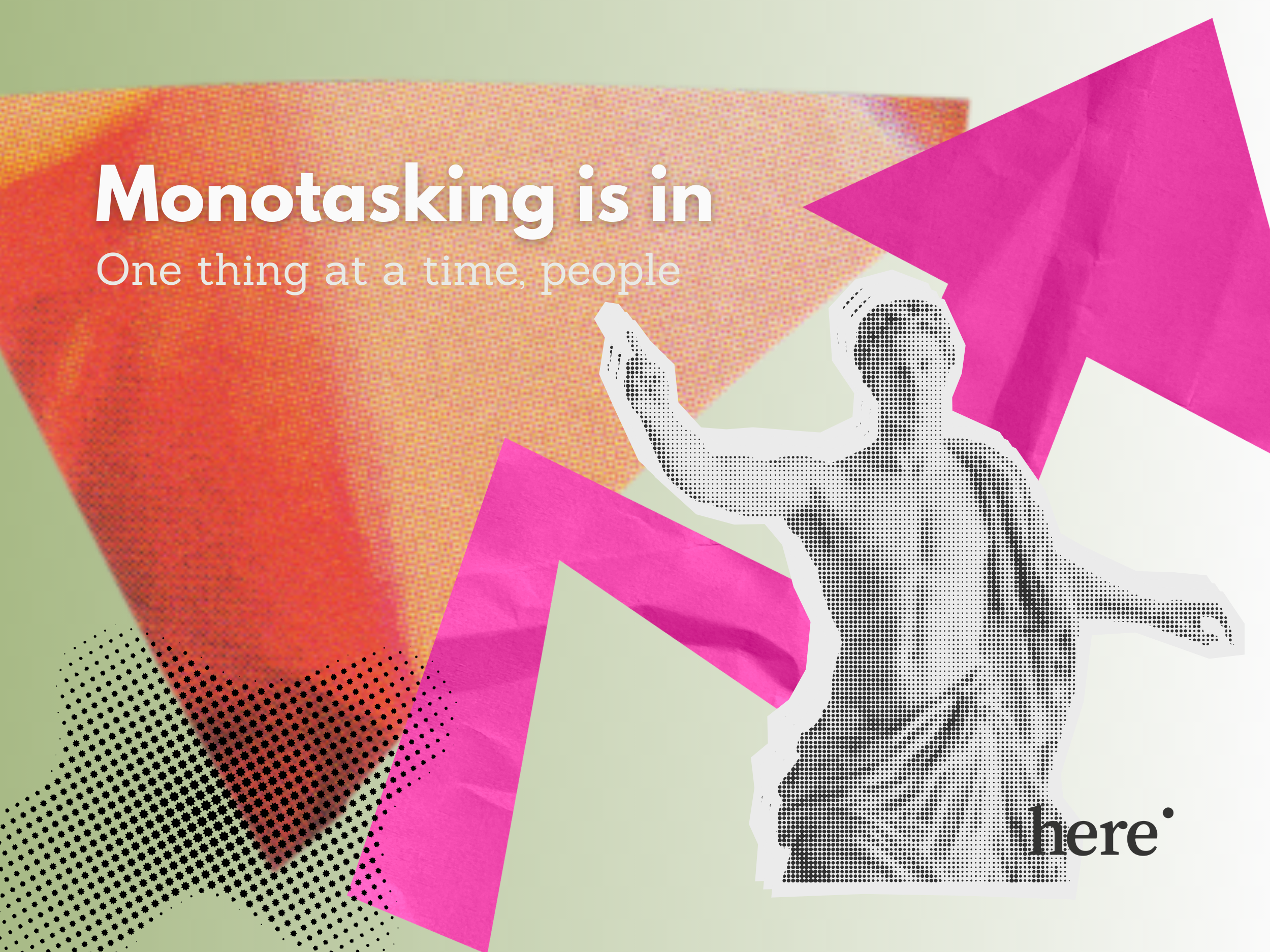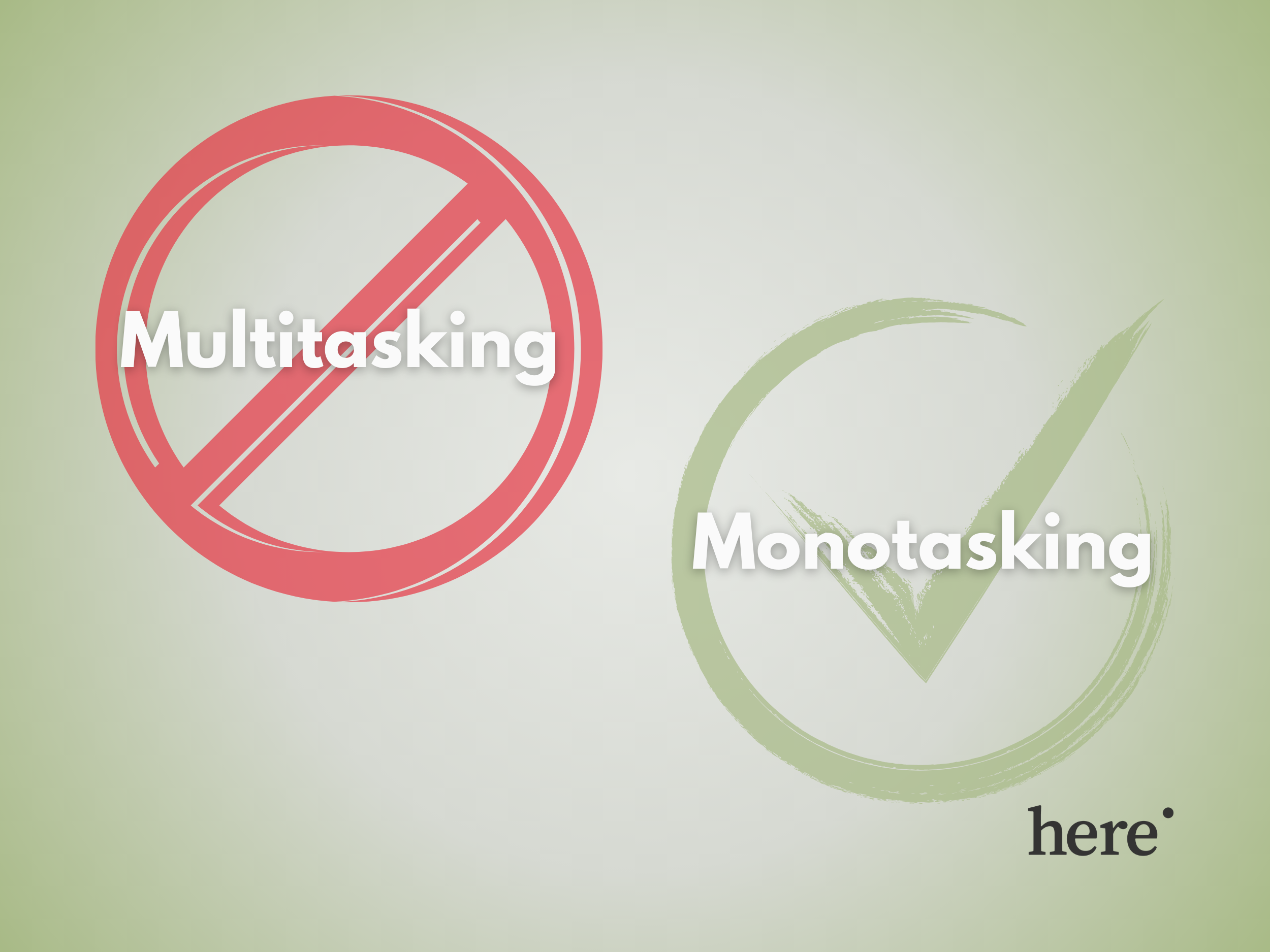Monotasking: Oprah's Word of the Week - What it is and Why it Matters
Introduction
Multitasking has long been glorified as the ultimate productivity flex, but here’s the problem: it’s exhausting.
Instead of helping us get more done, it often leaves us scattered, overwhelmed, and wondering where the day went.
On the flip side, we have monotasking—the simple yet powerful practice of doing one thing at a time.
Recently spotlighted as Oprah’s “word of the week,” monotasking is gaining traction among GenZ and Millennials as a tool to help reclaim focus, reduce stress, and protect their mental health.
But what makes monotasking more than just another trend?
It’s about bringing intention into your day, slowing down the chaos, and creating space to actually enjoy the work you’re doing.
Whether you’re tackling a to-do list or just trying to survive the workweek, monotasking might be exactly what you need to reset.
What Is Monotasking?
The Art of Single-Tasking
Monotasking, sometimes called single-tasking, is the practice of devoting your full attention to one task until it’s complete before moving on to the next. It’s a deliberate shift away from multitasking, where your focus gets pulled in ten directions at once. Think of it as giving your brain a breather—focusing on one thing at a time so you can show up fully for what matters.
Why It’s Catching On
Multitasking has been the default for so long that slowing down can feel almost rebellious. But as more people start noticing the toll of constant task-switching—burnout, mental fatigue, and that endless feeling of being “on”—monotasking is becoming a lifeline.
It’s not about working less; it’s about working smarter, with your focus on the task at hand instead of the dozens competing for your attention.
The Hidden Costs of Multitasking
It’s Not Productivity, It’s Chaos
On paper, multitasking sounds like a way to get ahead: answering emails while watching a webinar, scrolling social media during meetings, juggling multiple projects at once.
In reality, research shows that this constant switching can drop productivity by as much as 40%. Your brain needs time to adjust every time you change focus, which means you’re not working faster—you’re just working harder for the same result.
The Stress You Don’t See Coming
Beyond just slowing you down, multitasking takes a toll on your mental health. Switching gears repeatedly triggers stress hormones like cortisol, leaving you feeling anxious, scattered, and emotionally drained by the end of the day.
Add the pressure to stay constantly “on,” and it’s no wonder burnout rates are climbing.
Monotasking vs. Multitasking: What’s the Real Difference?
When it comes to getting things done, monotasking and multitasking couldn’t be more different. While multitasking might seem like a productivity hack, research shows that it often creates more problems than it solves. Here’s how the two approaches stack up:
Focus Management
Multitasking: Divides your attention across multiple tasks, forcing your brain to constantly switch gears. This phenomenon, called task switching, comes with a cognitive cost—each switch requires your brain to refocus, which drains energy and slows progress.
Monotasking: Keeps your focus locked on one task at a time, reducing mental strain and allowing you to complete work more efficiently. This single-tasking approach minimizes distractions and helps you manage your scope of work without feeling overwhelmed.
Impact on Productivity
Multitasking: Despite its reputation for boosting productivity, multitasking often reduces your level of productivity. Studies show that shifting focus repeatedly lowers the quality of your work and increases the likelihood of errors.
Monotasking: By dedicating your full attention to a single task, you can complete it faster and more accurately. This focused method is especially effective for projects that require critical thinking or creative problem-solving.
Cognitive Function and Memory Skills
Multitasking: Overloads your working memory, which can impair your ability to retain information. If you’ve ever found yourself forgetting details or struggling to follow through on tasks, multitasking could be the culprit.
Monotasking: Preserves cognitive function by reducing mental clutter. By staying present, you give your brain the space it needs to process and store information effectively.
Managing Multiple Deadlines
Multitasking: Creates the illusion of progress by tackling bits of multiple projects at once. However, this fragmented approach often leads to missed details and incomplete work.
Monotasking: Encourages prioritization, helping you tackle the most important tasks first. This method ensures steady progress on individual projects, even when juggling multiple deadlines.
Long-Term Benefits
Multitasking: Can contribute to mental fatigue and decreased focus over time, making it harder to sustain productivity in a global business environment that demands efficiency.
Monotasking: Builds better time management methods and strengthens your ability to concentrate, setting you up for long-term success.
Why the Shift Matters
The choice between multitasking and monotasking isn’t just about how you work—it’s about how you protect your mental health. While multitasking might feel like the norm, its hidden cognitive costs can leave you exhausted, frustrated, and prone to burnout. By contrast, monotasking aligns with mindfulness principles, encouraging a more intentional, balanced approach to your day.
Want to see the difference for yourself? Start with one task today. Turn off the distractions, set a timer, and give it your full attention. Chances are, you’ll finish faster, feel more accomplished, and even enjoy the process.
The Benefits of Monotasking for Mental Wellness
Focus Like You’ve Never Felt Before
Ever start one task only to get distracted and realize an hour later you haven’t finished anything? Monotasking flips that script. By zoning in on a single task, you give your brain permission to enter a state of deep focus, often called “flow.” It’s that sweet spot where creativity thrives, ideas click into place, and you’re fully immersed in what you’re doing. The result? Better work, done faster—and way less frustration.
A Buffer Against Burnout
Burnout doesn’t just happen overnight—it’s the accumulation of tiny stresses, mental overload, and the feeling that you’re never caught up. Monotasking helps protect your mental health by reducing that overload. By focusing on one thing at a time, you lower the cognitive strain on your brain, making it easier to stay energized and engaged throughout your day.
Emotional Well-Being in Every Task
There’s something calming about giving a task your undivided attention. Monotasking encourages mindfulness, pulling you into the present moment instead of worrying about everything else on your plate. It’s not just about getting things done; it’s about finding small moments of joy or satisfaction in the process, whether you’re writing a report, folding laundry, or finally organizing that messy kitchen drawer.
How to Start Monotasking
Start with Priorities
Monotasking works best when you know what’s worth focusing on. Each morning, pick one or two key tasks to prioritize. These are the non-negotiables—the things that, if accomplished, will make your day feel productive and purposeful. Write them down and tackle them one at a time.
Create a Distraction-Free Zone
Let’s face it: distractions are everywhere. To monotask effectively, you need to actively protect your focus. Put your phone on “Do Not Disturb,” close unnecessary browser tabs, and find a quiet space to work if possible. Apps like Focus@Will or Freedom can also help block interruptions and keep you on track.
Master the Art of Time Blocking
One of the simplest ways to ease into monotasking is with time blocking. Divide your day into dedicated chunks for specific tasks, with short breaks in between. Techniques like the Pomodoro Method (25 minutes of work followed by a 5-minute break) can help you stay productive without feeling drained.
Bring Mindfulness Into the Mix
Monotasking pairs perfectly with mindfulness. Before starting a task, take a deep breath and set a clear intention. As you work, notice when your mind starts to wander, and gently bring it back to the task at hand. It’s not about being perfect—it’s about practicing presence.
Applying Monotasking to Work and Life
Monotasking at Work
Work environments are often multitasking central—emails, meetings, Slack notifications, and a never-ending to-do list. But bringing monotasking into your professional life can transform the way you approach tasks and, ultimately, your productivity.
Reclaim Your Schedule: Start by blocking off dedicated focus time in your calendar, and treat it as sacred. This is your uninterrupted time for tackling complex tasks or creative projects. Let your coworkers know when you’re heads-down, and don’t feel guilty about ignoring non-urgent emails until you’re done.
Turn Off Notifications: Slack pings and email alerts are a productivity killer. Mute them temporarily while you focus, and set clear boundaries for when you’ll check messages.
Batch Similar Tasks: Instead of switching from writing a report to answering emails to working on a presentation, group similar activities together. For example, dedicate an hour to deep work, then follow it with 30 minutes of email time.
Monotasking at Home
Your personal life deserves the same level of intention as your work life. Monotasking at home can help you feel more present, less scattered, and more in tune with the people and activities you love.
Give Activities Your Full Attention: Whether it’s cooking dinner, helping your kids with homework, or catching up on your favorite show, resist the urge to multitask. Fully immerse yourself in the moment, and you’ll enjoy it more.
Create a To-Do List with Purpose: Narrow down your list to the top priorities for the day instead of trying to do it all. It’s better to finish three meaningful tasks than half-finish ten.
Unplug During Personal Time: Turn off screens and focus on one offline activity, like reading, journaling, or taking a walk. This not only helps you recharge but also gives your brain a break from digital overload.
Balancing Digital Habits with Monotasking
Technology can make or break your monotasking goals. While our devices are essential for staying connected, they can also pull us into the multitasking trap.
Set App Limits: Use tools like Screen Time (iOS) or Digital Wellbeing (Android) to limit how often you access distracting apps during the day.
Designate Phone-Free Zones: Keep devices out of certain areas, like your bedroom or dining table, to create space for uninterrupted focus.
Schedule Social Media Time: Instead of checking your feeds throughout the day, carve out a specific window for scrolling. This ensures you’re still connected without letting notifications take over your schedule.
Conclusion
Monotasking isn’t just about focusing better—it’s about living better. By shifting your attention from doing more to doing one thing well, you can protect your mental health, reduce stress, and find more joy in both work and life. It’s not always easy, especially in a world that rewards constant busyness, but the benefits are well worth it.
Start small: pick one task today, give it your full attention, and see how it feels. You might be surprised at how freeing it is to let go of the multitasking myth—and how much more you accomplish when you focus on what matters most.


